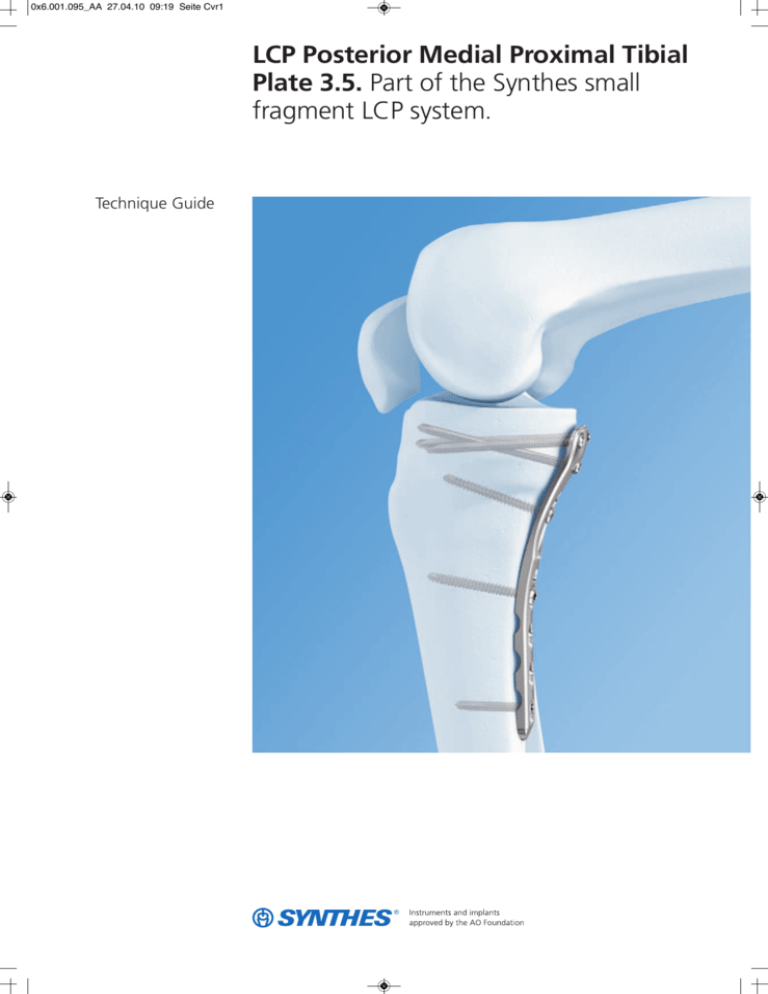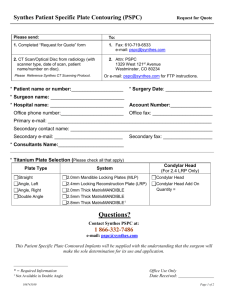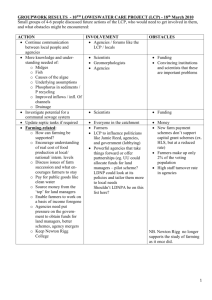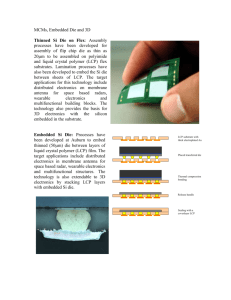
0x6.001.095_AA 27.04.10 09:19 Seite Cvr1
LCP Posterior Medial Proximal Tibial
Plate 3.5. Part of the Synthes small
fragment LCP system.
Technique Guide
0x6.001.095_AA 27.04.10 09:19 Seite Cvr2
0x6.001.095_AA 27.04.10 09:19 Seite 1
Table of Contents
Introduction
Surgical Technique
Product Information
LCP Posterior Medial Proximal Tibial Plate 3.5
2
AO Principles
4
Indications
5
Preoperative Planning
6
Preparation
7
Approach
– Posteromedial
– Posterior
8
10
Fracture Reduction and Screw Insertion
12
Alternative Technique for Screw Lengths up to 60 mm
18
Plates
20
Screws
21
Instruments
22
Sets
24
Image intensifier control
Warning
This description alone does not provide sufficient background for direct use of
the instrument set. Instruction by a surgeon experienced in handling these
instruments is highly recommended.
Reprocessing, Care and Maintenance of
Synthes Instruments
For general guidelines, function control and dismantling of multi-part instruments,
please refer to: www.synthes.com/reprocessing
Synthes
1
0x6.001.095_AA 27.04.10 09:19 Seite 2
LCP Posterior Medial Proximal Tibial
Plate 3.5. Part of the Synthes small
fragment LCP system.
The LCP Posterior Medial Proximal Tibial Plate 3.5 is part of
the Synthes small fragment LCP system that merges locking
screw technology with conventional plating techniques.
The LCP Posterior Medial Proximal Tibial Plate 3.5 is available
in stainless steel or titanium and has a limited-contact shaft
profile. The head and neck portions of the plate accept locking, conical and cortex screws ⭋ 3.5 mm or cancellous bone
screws ⭋ 4.0 mm.
Screw divergence
The two proximal screw holes have 10° divergent trajectories,
each diverging 5° from the plate midline.
2
Synthes
LCP Posterior Medial Proximal Tibial Plate 3.5
Technique Guide
0x6.001.095_AA 27.04.10 09:19 Seite 3
Features
– Plate tapers from 3.4 mm to 1.9 mm
thick
– Available with 1, 2, 4, 6, 8 or
10 holes in the plate shaft
– Available in implant-quality 316 L
stainless steel or titanium alloy
(Ti-6Al-7Nb)
Option for rafting
screws
Low-profile head
(1.9 mm thick)
Combi-holes allow locking
or compression options
Elongated combi-holes in the
neck and shaft facilitate plate
adjustment and allow locking or
compression
Limited-contact surface reduces
bone-to-plate contact and helps
to preserve the periosteal blood
supply
Synthes
3
0x6.001.095_AA 27.04.10 09:19 Seite 4
AO Principles
In 1958, the AO formulated four basic principles, which have
become the guidelines for internal fixation.1, 2 Those principles, as applied to the LCP Posterior Medial Proximal Tibial
Plate 3.5 are:
Anatomic reduction
Restoration of the bone by exact screw placement using
threaded drill sleeves.
Stable fixation
Locking screws create a fixed-angle construct, providing
angular stability.
Preservation of blood supply
Tapered end for submuscular plate insertion. Limited-contact
shaft profile reduces plate-to-bone contact and minimizes
vascular trauma.
Early, active mobilization
Plate features combined with AO technique create an
environment for bone healing, expediting a return to optimal
function.
1
2
4
Müller ME, Allgöwer M, Schneider R, Willenegger H (1995) Manual of Internal
Fixation. 3rd, expanded and completely revised ed. 1991. Berlin, Heidelberg,
New York: Springer
Rüedi TP, Buckley RE, Moran CG (2007) AO Principles of Fracture Management.
2nd expanded ed. 2002. Stuttgart, New York: Thieme
Synthes
LCP Posterior Medial Proximal Tibial Plate 3.5
Technique Guide
0x6.001.095_AA 27.04.10 09:19 Seite 5
Indications
The Synthes LCP Posterior Medial Proximal Tibial Plate 3.5 is
indicated for internal fixation of posteromedial proximal tibia
fractures including buttressing of fractures of the proximal,
distal and metaphyseal areas of the tibia.
Synthes
5
0x6.001.095_AA 27.04.10 09:19 Seite 6
Preoperative Planning
Use the preoperative planning template for the LCP Posterior
Medial Proximal Tibial Plate 3.5 (034.000.657).
LCP Posterior Medial Proximal Tibial Plate 3.5
Important: Determine proximal screw placement and screw
lengths to ensure proper screw placement in the metaphysis.
20
30
40
50
60
70
For use only with the Original AO/ASIF System of
Instruments and Implants
Synthes GmbH
Eimattstrasse 3
CH-4436 Oberdorf
www.synthes.com
6
Synthes
LCP Posterior Medial Proximal Tibial Plate 3.5
Technique Guide
80
90
100 mm
X=2: Stainless Steel
X=4: Titanium
0X.120.701
0X.120.702
0X.120.704
0X.120.706
0X.120.708
0X.120.710
Holes
1
2
4
6
8
10
Length
69 mm
79 mm
105 mm
131 mm
157 mm
183 mm
30100095
10
034.000.657 AA
1.10 Magnification
0
© 12/2009 Synthes, Inc. or its affiliates
All rights reserved
AP view
Synthes and LCP are trademarks of Synthes, Inc. or its affiliates
Locking Screw " 3.5 mm, self-tapping,
Length
X13.040
40 mm
X13.045
45 mm
X13.050
50 mm
X13.055
55 mm
X13.060
60 mm
X13.065
65 mm
X13.070
70 mm
X13.075
75 mm
X13.080
80 mm
X13.085
85 mm
v13.090
90 mm
Ö034.000.657öAA_ä
Lateral view
Complete the radiographic assessment and prepare the
preoperative plan. Determine plate length and instruments
to be used.
0x6.001.095_AA 27.04.10 09:19 Seite 7
Preparation
Sets
01.120.702
or
01.120.703
LCP Posterior Medial Proximal Tibial Plates
3.5 (Stainless Steel), in Modular Tray,
Vario Case System
LCP Posterior Medial Proximal Tibial Plates
3.5 (TAN), in Modular Tray, Vario Case
System
01.122.013
Small Fragment Basic Instruments, in
Modular Tray, Vario Case System
01.122.015
Screw Insertion Instruments 3.5/4.0, in
Modular Tray, Vario Case System
Optional instruments
394.350
Large Distractor, complete
323.055
Centering Sleeve for Kirschner Wire
⭋ 1.6 mm, length 70 mm, for
Nos. 323.027 and 323.054
312.648*
LCP Drill Sleeve 3.5, for Drill Bits ⭋ 2.8 mm
324.214*
Drill Bit ⭋ 2.8 mm, with Scale, length
200/100 mm, 3-flute, for Quick Coupling
(for use with 312.648)
319.090*
Depth Gauge for Long Screws ⭋ 3.5 mm,
measuring range up to 110 mm
* Required for inserting LCP and conical screws longer than
60 mm
Note: For information on fixation principles using conventional and locked plating techniques, please refer to the
Synthes LCP Locking Compression Plate Surgical Technique
Guide (036.000.019).
Synthes
7
0x6.001.095_AA 27.04.10 09:19 Seite 8
Approach – Posteromedial
1
Position patient
Position the patient on a radiolucent operating table.
Visualization of the proximal tibia under fluoroscopy in both
the lateral and AP views is necessary.
If the patient’s hip is normal, position the patient supine,
abduct and externally rotate the leg and put it in a figure of
four position. A bump under the contralateral hip may help.
If the hip is stiff, position the patient in a lateral decubitus
with the involved limb down.
2
Make incision
With the knee in slight flexion, make a straight or slightly
curved incision running from the medial epicondyle toward
the posteromedial edge of the tibia. The incision can be extended as needed both proximally and distally.
8
Synthes
LCP Posterior Medial Proximal Tibial Plate 3.5
Technique Guide
0x6.001.095_AA 27.04.10 09:19 Seite 9
3
Identify and expose pes anserinus
After opening the fascia, identify and expose the pes
anserinus.
4
Access tibial plateau
Retract the pes anteriorly and the gastrocnemius posteriorly
and distally. Identify the medial edge of the tibial plateau.
Identify the meniscus and incise the capsule between the
meniscus and the edge of the tibial plateau, gaining access
to the knee joint.
Synthes
9
0x6.001.095_AA 27.04.10 09:19 Seite 10
Approach – Posterior
The posteromedial side can be approached without exposing
and dissecting the neurovascular structures. The posterior
approach allows repair of avulsion fractures of the posterior
cruciate and tangential fractures of the proximal tibial head.
1
Position patient
Position the patient prone on a radiolucent operating table.
Visualization of the proximal tibia under fluoroscopy in both
the lateral and AP views is necessary.
2
Make incision
Make a lazy S-shaped incision in the popliteal fossa.
The incision should extend about 8 cm proximally and distally
from the joint line.
3
Open crural fascia
Open the crural fascia. Identify and save the short saphenous
vein and the medial sural cutaneous nerve.
10
Synthes
LCP Posterior Medial Proximal Tibial Plate 3.5
Technique Guide
0x6.001.095_AA 27.04.10 09:19 Seite 11
4
Retract semimembranosus muscle
Identify the semimembranosus muscle and retract it medially.
The origin of the medial head of gastrocnemius becomes visible.
5
Expose
Identify the anterior edge of the gastrocnemius and retract
the muscle laterally. The muscle will protect the important
neurovascular bundle.
Option: Transection of the gastrocnemius close to its origin
may allow easier retraction and protection of the neurovascular bundle.
The posteromedial capsule comes into view. It can be incised
where necessary to expose the fracture lines.
Alternative technique
Alternatively, a Lobenhoffer approach may be used.3
3
Fakler JK, et al (2007). Optimizing the Management of Moore Type I
Postero-Medial Split Fracture Dislocations of the Tibial Head: Description of the
Lobenhoffer Approach. J Orthop Trauma 21(5):330-336
Synthes
11
0x6.001.095_AA 27.04.10 09:19 Seite 12
Fracture Reduction and Screw
Insertion
1
Reduce fracture
Instruments
394.350
Large Distractor, complete
Kirschner Wires
Technique tip: Before reduction, application of an external
fixator or large distractor may facilitate visualization and reduction of the joint.
Reduce the fracture fragments and confirm reduction using
fluoroscopy. Fragments may be reduced using independent
Kirschner wires.
The locking screws do not provide interfragment or plate-tobone compression; therefore, any desired compression must
be achieved with conical screws ⭋ 3.5 mm in the plate or
independent lag screws.
Technique tip: To verify that independent lag screws will not
interfere with plate placement, hold the plate to the bone.
12
Synthes
LCP Posterior Medial Proximal Tibial Plate 3.5
Technique Guide
0x6.001.095_AA 27.04.10 09:19 Seite 13
2
Position plate
Instruments
310.250
Drill Bit ⭋ 2.5 mm, length 110/85 mm,
2-flute, for Quick Coupling
314.070
Screwdriver, hexagonal, small, ⭋ 2.5 mm,
with Groove
314.030
Screwdriver Shaft, hexagonal, small,
⭋ 2.5 mm
319.010
Depth Gauge for Screws ⭋ 2.7 to 4.0 mm,
measuring range up to 60 mm
323.360
Universal Drill Guide 3.5
Alternative instrument
319.090
Depth Gauge for Long Screws ⭋ 3.5 mm,
measuring range up to 110 mm
Using anatomic landmarks and fluoroscopy, mount the plate
on the bone.
Place the universal drill guide 3.5 into the nonlocking portion
of an elongated plate hole. Use the 2.5 mm drill bit to drill
into the bone.
The plate may be temporarily held in place by a cortex screw
⭋ 3.5 mm or cancellous bone screw ⭋ 4.0 mm.
Notes
– When used as a buttress plate, cortex screws placed
through the plate below the fragment can be used to assist with indirect reduction of the fragment. Placing a nonlocking screw in an elongated LCP hole below the fragment allows easy adjustment of plate positioning before
inserting screws into combi holes in the shaft or plate
head.
– It is not recommended to drill through both cortices as the
posteromedial position of the plate may direct the drill bit
into the anterior soft tissues. The tibial tubercle is a suggested aiming point.
Synthes
13
0x6.001.095_AA 27.04.10 09:19 Seite 14
Fracture Reduction and Screw Insertion
3
1
Insert cortex screws
Instruments
310.250
Drill Bit ⭋ 2.5 mm, length 110/85 mm,
2-flute, for Quick Coupling
314.070
Screwdriver, hexagonal, small, ⭋ 2.5 mm,
with Groove
314.030
Screwdriver Shaft, hexagonal, small,
⭋ 2.5 mm
319.010
Depth Gauge for Screws ⭋ 2.7 to 4.0 mm,
measuring range up to 60 mm
323.360
Universal Drill Guide 3.5
Alternative instrument
319.090
Depth Gauge for Long Screws ⭋ 3.5 mm,
measuring range up to 110 mm
Measure for screw length with the depth gauge. (1)
2
Insert a screw with a small hexagonal screwdriver manually
or under power. Determine the final position of the plate before tightening completely. (2)
Insert additional cortex screws in combi holes as necessary
using the above technique.
For the neutral position within a combi hole, press the drill
guide down in the nonthreaded portion of the hole. To obtain compression, place the drill guide at the end of the nonthreaded hole away from the fracture. Do not apply downward pressure on the drill guide’s spring-loaded tip.
Important: All of the cortex or cancellous bone screws must
be inserted before insertion of locking screws ⭋ 3.5 mm.
14
Synthes
LCP Posterior Medial Proximal Tibial Plate 3.5
Technique Guide
0x6.001.095_AA 27.04.10 09:19 Seite 15
4
1
Insert locking screws
Instruments
310.284
LCP Drill Bit ⭋ 2.8 mm with Stop, length
165 mm, 2-flute, for Quick Coupling
323.027
LCP Drill Sleeve 3.5, for Drill Bits ⭋ 2.8 mm
314.116
Screwdriver Shaft Stardrive 3.5, T15,
self-holding, for AO/ASIF Quick Coupling
311.431
Handle with Quick Coupling
319.010
Depth Gauge for Screws ⭋ 2.7 to 4.0 mm,
measuring range up to 60 mm
511.770
Torque Limiter, 1.5 Nm, for Compact Air
Drive and Power Drive
or
511.773
Torque Limiter, 1.5 Nm, for AO/ASIF
Quick Coupling
Thread the LCP drill sleeve 3.5 into an appropriate locking
hole.
2
Use the LCP drill bit ⭋ 2.8 mm to drill into the bone. (1)
Remove the LCP Drill Sleeve 3.5 and measure with the depth
gauge. (2)
Synthes
15
0x6.001.095_AA 27.04.10 09:19 Seite 16
Fracture Reduction and Screw Insertion
Insert the appropriate length locking screw using a Stardrive
screwdriver.
Notes
– Ensure proper reduction before inserting the first locking
screw. Once the locking screws are inserted, further
reduction is not possible without loosening the locking
screws.
– Always use a torque limiting attachment when using
power to insert locking screws. Final tightening should be
performed by hand.
Note: If longer screws (65 mm – 95 mm) are used, alternative
instruments may be needed.
Alternative instruments
319.090
Depth Gauge for Long Screws ⭋ 3.5 mm,
measuring range up to 110 mm
312.648
LCP Drill Sleeve 3.5, for Drill Bits ⭋ 2.8 mm
324.214
Drill Bit ⭋ 2.8 mm, with Scale, length
200/100 mm, 3-flute, for Quick Coupling
(for use with 312.648)
16
LCP Posterior Medial Proximal Tibial Plate 3.5
Synthes
Technique Guide
0x6.001.095_AA 27.04.10 09:19 Seite 17
Insert additional locking screws as necessary.
Synthes
17
0x6.001.095_AA 27.04.10 09:19 Seite 18
Alternative Technique for Screw
Lengths up to 60 mm
1
1
Screw placement verification with Kirschner wire
Instruments
292.160
Kirschner Wire ⭋ 1.6 mm with trocar tip,
length 150 mm, Stainless Steel
310.284
LCP Drill Bit ⭋ 2.8 mm with Stop,
length 165 mm, 2-flute, for Quick
Coupling
323.027
LCP Drill Sleeve 3.5, for Drill Bits ⭋ 2.8 mm
323.055
Centering Sleeve for Kirschner Wire
⭋ 1.6 mm, length 70 mm, for
Nos. 323.027 and 323.054
511.770
Torque Limiter, 1.5 Nm, for Compact Air
Drive and Power Drive
or
511.773
Torque Limiter, 1.5 Nm, for AO/ASIF
Quick Coupling
Attach a LCP drill sleeve 3.5 to the plate. Insert a centering
sleeve for Kirschner wire ⭋ 1.6 mm into the LCP drill
sleeve. (1)
2
Insert a 1.6 mm Kirschner wire through the centering sleeve
and drill to the desired depth.
Verify Kirschner wire placement under image intensification
to determine if final screw placement is acceptable. (2)
Important: The Kirschner wire position represents the final
position of the locking screw. Confirm that the Kirschner
wire does not enter or interfere with the joint or other
screws.
18
Synthes
LCP Posterior Medial Proximal Tibial Plate 3.5
Technique Guide
0x6.001.095_AA 27.04.10 09:19 Seite 19
2
1
Measure for screw length and insert screw
Instruments
314.070
Screwdriver, hexagonal, small, ⭋ 2.5 mm,
with Groove
314.116
Screwdriver Shaft Stardrive 3.5, T15,
self-holding, for AO/ASIF Quick Coupling
311.431
Handle with Quick Coupling
323.060
PHILOS Direct Measuring Device for
Kirschner Wire ⭋ 1.6 mm
Measurement may be taken by sliding the tapered end of the
direct measuring device over the Kirschner wire and down to
the centering sleeve. (1)
Remove the direct measuring device, Kirschner wire and
centering sleeve, leaving the LCP drill sleeve 3.5 in place.
Use the LCP drill bit ⭋ 2.8 mm to drill the near cortex. (2)
Remove the LCP drill sleeve 3.5. Insert the appropriate length
locking screw.
2
Insert additional locking screws as necessary.
Synthes
19
0x6.001.095_AA 27.04.10 09:19 Seite 20
Plates
LCP Posterior Medial Proximal Tibial Plate 3.5*
Stainless steel
Titanium
Shaft holes
Length
(mm)
02.120.701
04.120.701
1
69
02.120.702
04.120.702
2
79
02.120.704
04.120.704
4
105
02.120.706
04.120.706
6
131
02.120.708
04.120.708
8
157
02.120.710
04.120.710 10
183
* Available non-sterile or sterile packed. Add “S” to catalog number to order
sterile product.
20
Synthes
LCP Posterior Medial Proximal Tibial Plate 3.5
Technique Guide
0x6.001.095_AA 27.04.10 09:19 Seite 21
Screws
Locking Screw ⭋ 3.5 mm, self-tapping
– Threaded conical head
– Fully threaded shaft
– Hexagonal or Stardrive recess
– Self-tapping tip
– Lengths: 10 mm – 95 mm
Titanium
Stainless Steel
413.010 - 413.095
213.010 - 213.095
412.101 - 412.131
212.101 - 212.131
Screw ⭋ 3.5 mm with Conical Head, self-tapping,
short thread
– Smooth conical head
– Partially threaded shaft
– Hexagonal or Stardrive recess
– Self-tapping tip
– Lengths: 40 mm – 95 mm
Titanium
Stainless Steel
412.467 - 412.481
212.467 - 212.481
412.417 - 412.431
212.417 - 212.431
Screw ⭋ 3.5 mm with Conical Head, self-tapping,
fully threaded
– Smooth conical head
– Fully threaded shaft
– Hexagonal or Stardrive recess
– Self-tapping tip
– Lengths: 40 mm – 95 mm
Titanium
Stainless Steel
412.367 - 412.381
212.367 - 212.381
412.317 - 412.331
212.317 - 212.331
Cortex Screw ⭋ 3.5 mm, self-tapping, hexagonal recess
– May be used in the DCU portion of the combi-holes
– Used to compress the plate to the bone or create axial
compression
– Self-tapping tip
– Lengths: 10 mm – 110 mm
Titanium
Stainless Steel
404.810 - 409.910
204.810 - 209.910
Synthes
21
0x6.001.095_AA 27.04.10 09:19 Seite 22
Instruments
394.350
Large Distractor
323.055
Centering Sleeve for Kirschner Wire
⭋ 1.6 mm, length 70 mm, for
Nos. 323.027 and 323.054
312.648*
LCP Drill Sleeve 3.5, for Drill Bits ⭋ 2.8 mm
324.214*
Drill Bit ⭋ 2,8 mm, with Scale,
length 200/100 mm, 3-flute, for
Quick Coupling
319.090*
Depth Gauge for Long Screws ⭋ 3.5 mm,
measuring range up to 110 mm
310.250
Drill Bit ⭋ 2.5 mm, length 110/85 mm,
2-flute, for Quick Coupling
314.070
Screwdriver, hexagonal, small, ⭋ 2.5 mm,
with Groove
314.030
Screwdriver Shaft, hexagonal, small,
⭋ 2.5 mm
319.010
Depth Gauge for Screws ⭋ 2.7 to 4.0 mm,
measuring range up to 60 mm
323.360
Universal Drill Guide 3.5
* Required for inserting LCP and conical screws longer than
60 mm
22
Synthes
LCP Posterior Medial Proximal Tibial Plate 3.5
Technique Guide
0x6.001.095_AA 27.04.10 09:19 Seite 23
310.284
LCP Drill Bit ⭋ 2.8 mm with Stop, length
165 mm, 2-flute, for Quick Coupling
323.027
LCP Drill Sleeve 3.5, for Drill Bits ⭋ 2.8 mm
314.116
Screwdriver Shaft Stardrive 3.5, T15,
self-holding, for AO/ASIF Quick Coupling
311.431
Handle with Quick Coupling
511.770
Torque Limiter, 1.5 Nm, for Compact Air
Drive and Power Drive
or
511.773
Torque Limiter, 1.5 Nm, for AO/ASIF Quick
Coupling
292.160
Kirschner Wire ⭋ 1.6 mm with trocar tip,
length 150 mm, Stainless Steel
323.055
Centering Sleeve for Kirschner Wire
⭋ 1.6 mm, length 70 mm, for
Nos. 323.027 and 323.054
292.180
Kirschner Wire ⭋ 1.6 mm with trocar tip,
length 280 mm, Stainless Steel
323.060
PHILOS Direct Measuring Device for
Kirschner Wire ⭋ 1.6 mm
Synthes
23
0x6.001.095_AA 27.04.10 09:19 Seite 24
Sets
LCP Posterior Medial Proximal Tibial Plate Set 3.5 in
Vario Case
01.120.702
LCP Posterior Medial Proximal Tibial
Plates 3.5 – SSt
01.120.703
LCP Posterior Medial Proximal Tibial
Plates 3.5 – TAN
68.120.702
Modular Tray for LCP Posterior Medial
Proximal Tibial Plates 3.5, size 1/2, without
Contents, Vario Case System
684.060
Lid for Modular Tray, size 1/2
689.513
Vario Case, Framing, size 1/2,
height 45 mm
689.515
Vario Case, Framing, size 1/2,
height 88 mm
689.516
Vario Case, Framing, size 1/2,
height 126 mm
689.537
Lid (Stainless Steel), size 1/2, for Vario Case
68.120.703
Labelling Clip for LCP Posterior Medial
Proximal Tibial Plate Set 3.5, System
Vario Case
01.122.013
Small Fragment Basic Instruments, in
Modular Tray, Vario Case System
684.060
Lid for Modular Tray, size 1/2
68.122.013
Modular Tray for Small Fragment Basic
Instruments, size 1/2, without content,
Vario Case System
01.122.015
Screw Insertion Instruments 3.5/4.0, in
Modular Tray, Vario Case System
684.060
Lid for Modular Tray, size 1/2
68.122.015
Modular Tray for Screw Insertion 3.5/4.0,
size 1/2, without content,
Vario Case System
24
LCP Posterior Medial Proximal Tibial Plate 3.5
Synthes
Technique Guide
0x6.001.095_AA 27.04.10 09:19 Seite Cvr3
All technique guides are available as PDF files at
www.synthes.com/lit
0123
30100066
Ö036.001.095öAAHä
036.001.095 AA
© 04/2010 Synthes, Inc. or its affiliates
All rights reserved
Synthes, Vario Case and Stardrive are trademarks of Synthes, Inc. or its affiliates
0x6.001.095_AA 27.04.10 09:19 Seite Cvr4






